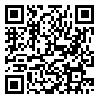دوره 6، شماره 2 - ( 2-1401 )
جلد 6 شماره 2 صفحات 136-126 |
برگشت به فهرست نسخه ها
Download citation:
BibTeX | RIS | EndNote | Medlars | ProCite | Reference Manager | RefWorks
Send citation to:



BibTeX | RIS | EndNote | Medlars | ProCite | Reference Manager | RefWorks
Send citation to:
Ahadinezhad B, Khosravizadeh O, Vahdati F, Mohammadkhani M, Soheylirad R, Sarikhani S. Investigating the Relationship Between Management Style and Market Orientation in Qazvin University of Medical Sciences. EBHPME 2022; 6 (2) :126-136
URL: http://jebhpme.ssu.ac.ir/article-1-351-fa.html
URL: http://jebhpme.ssu.ac.ir/article-1-351-fa.html
Investigating the Relationship Between Management Style and Market Orientation in Qazvin University of Medical Sciences. 1. 1401; 6 (2) :126-136
چکیده: (913 مشاهده)
Background: Hospital management style can affect various aspects of hospital performance. One of these aspects is the level of market orientation of the hospital. Therefore, the present study attempts to answer whether management style makes a difference in the degree market orientation of hospitals or not.
Methods: This research is a descriptive-analytical and cross-sectional study conducted in 2020. About 420 people were selected by stratified sampling out of the six medical centers' staff in Qazvin, Iran. A total of 411 people (97.86 %) completed the questionnaires. The collected data were analyzed using STATA15 and SPSS16 software. Robust regression analysis was used to estimate the role of management style in the level of market orientation of hospitals. Mean variables were analyzed using one-way analysis of variance and post hoc test.
Results: The score range of the variables was from 1 to 5. Autocratic and delegating styles obtained the highest average (3.22 ± 0.54) and the lowest average (2.87 ± 0.70), respectively. Among the dimensions of market orientation, customer orientation had the highest average (3.32 ± 0.84), while competitor orientation obtained the lowest average (2.80 ± 0.86). The average score of market orientation was 2.88 ± 0.65. A statistically significant difference between hospitals was observed in terms of participative and delegating styles (P-value < 0.05). In addition to market orientation, there was a statistically significant difference between hospitals (P-value < 0.05). The regression coefficient between the level of the hospital market orientation and the participative and delegating styles was 0.10 and 0.09
, respectively (P-value < 0.05). In contrast, the regression coefficient between autocratic style and level of market orientation was estimated to be -0.76.
Conclusion: It can be concluded that managers should use more participatory and delegating styles to increase the market orientation of the studied hospitals.
Methods: This research is a descriptive-analytical and cross-sectional study conducted in 2020. About 420 people were selected by stratified sampling out of the six medical centers' staff in Qazvin, Iran. A total of 411 people (97.86 %) completed the questionnaires. The collected data were analyzed using STATA15 and SPSS16 software. Robust regression analysis was used to estimate the role of management style in the level of market orientation of hospitals. Mean variables were analyzed using one-way analysis of variance and post hoc test.
Results: The score range of the variables was from 1 to 5. Autocratic and delegating styles obtained the highest average (3.22 ± 0.54) and the lowest average (2.87 ± 0.70), respectively. Among the dimensions of market orientation, customer orientation had the highest average (3.32 ± 0.84), while competitor orientation obtained the lowest average (2.80 ± 0.86). The average score of market orientation was 2.88 ± 0.65. A statistically significant difference between hospitals was observed in terms of participative and delegating styles (P-value < 0.05). In addition to market orientation, there was a statistically significant difference between hospitals (P-value < 0.05). The regression coefficient between the level of the hospital market orientation and the participative and delegating styles was 0.10 and 0.09
, respectively (P-value < 0.05). In contrast, the regression coefficient between autocratic style and level of market orientation was estimated to be -0.76.
Conclusion: It can be concluded that managers should use more participatory and delegating styles to increase the market orientation of the studied hospitals.
نوع مطالعه: پژوهشي |
دریافت: 1400/3/3 | پذیرش: 1401/2/30 | انتشار: 1401/4/12
دریافت: 1400/3/3 | پذیرش: 1401/2/30 | انتشار: 1401/4/12
| بازنشر اطلاعات | |
 |
این مقاله تحت شرایط Creative Commons Attribution-NonCommercial 4.0 International License قابل بازنشر است. |




